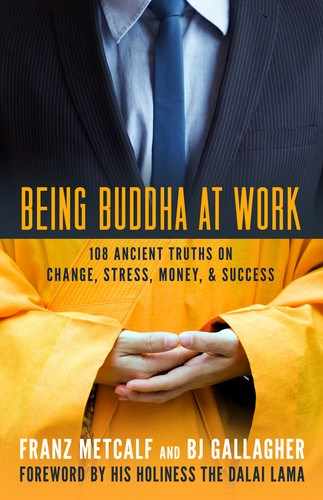 Notes on Sources
Notes on Sources
A Word about Sources
Traditionally, the words in the suttas assembled in the five nikayas (“groups” or “collections”) are accepted as the ipsissima verba, the actual words of the Buddha. So, when we quote from any text that has the word Nikaya in its title, we are quoting the Buddha directly.
We also quote from many other sutras and texts not in those collections. Two of these sources, the Bodhicharyavatara and the Dhammapada, deserve special mention here.
The Bodhicharyavatara is a book-length poem written by the monk Shantideva over a thousand years ago. Unusually for a Buddhist text, it attends closely to the needs and troubles of us householders. That is, we folks who work instead of meditate for a living. For this reason, we quote the Bodhicharyavatara often and recommend it highly.
The Dhammapada is an early compendium of many short phrases and teachings of the Buddha. It is both powerful and pithy—a rare combination. The Dhammapada is one of the most beloved texts in the Buddhist tradition, and one of our favorites, as you can see in this book.
Notes
Part I: Becoming a Mindful Worker
Choosing Mindful Work: Creating Right Livelihood
1. Steven Sanfield, “A Poem for Those of You Who Are Sometimes Troubled by Barking Dogs and Low Flying Jets,” in American Zen: By a Guy Who Tried It (Monterey, KY: Larkspur Press, 1994), 29.
Practical Enlightenment: Chop Wood, Carry Water
1. Shunyu Suzuki, Zen Mind, Beginner’s Mind (New York and Tokyo: Weatherhill, 1970), 21.
Quality of Work Life: The Middle Way at Work
1. Philip Toshio Sudo, Zen Computer: Mindfulness and the Machine (New York: Simon & Schuster, 1999), 67.
2. Robert Aitken, Encouraging Words: Zen Buddhist Teachings for Western Students (New York: Pantheon, 1993), 116.
Being Successful: How Do You Define Success?
1. Bstan-’dzin-rgya-mtsho (the XIV Dalai Lama), The Spirit of Tibet, Vision for Human Liberation: Selected Speeches and Writings of HH the Dalai Lama (New Delhi: Tibetan Parliamentary and Policy Research Centre in association with Vikas Publishing House, 1996), 253.
Money and Happiness: What’s the Connection?
1. Bhante Henepola Gunaratana, rev. ed., Mindfulness in Plain English (Boston: Wisdom Publications, 1996), 41.
Dealing with Change: Riding the Waves of Impermanence
1. Ajahn Brahm, Who Ordered This Truckload of Dung?: Inspiring Stories for Welcoming Life’s Difficulties (Boston: Wisdom Publications, 2005), 257–58.
2. Pema Chödrön, The Places That Scare You: A Guide to Fearlessness in Difficult Times (Boston: Shambhala Publications, 2002), 18.
3. Anne Cushman, “What Is Death, Mommy?” in The Best Buddhist Writing 2006 (Boston: Shambhala Publications, 2006), 59.
4. Lama Thubten Yeshe, The Bliss of Inner Fire: Heart Practice of the Six Yogas of Naropa (Boston: Wisdom Publications, 1998), 41.
5. Pema Chödrön, Start Where You Are: A Guide to Compassionate Living (Boston: Shambhala Publications, 2004), 6.
Part II: Cultivating Mindful Work Relationships
Working with Others: Unity in Diversity
1. David Chadwick, To Shine One Corner of the World: Moments with Shunryu Suzuki (New York: Broadway Books, 2001), 245.
2. Thich Nhat Hanh, Peace Is Every Step: The Path of Mindfulness in Everyday Life (New York: Bantam Books, 1991), 91.
Customers—Love ’Em or Lose ’Em: Customer Service as Bodhisattva Activity
1. The XIV Dalai Lama, in The Dalai Lama: A Policy of Kindness (Ithaca, NY: Snow Lion Publications, 1990), 51.
Part III: Creating a Mindful Workplace
1. Dona Witten and Akong Tulku Rinpoche, Enlightened Management: Bringing Buddhist Principles to Work (Rochester, VT: Park Street Press, 1999), 3.
The Big Issues: Beyond the Bottom Line
1. Christina Feldman and Jack Kornfield, eds, Stories of the Spirit, Stories of the Heart: Parables of the Spiritual Path from Around the World (San Francisco: HarperCollins, 1991), 250.
Work Practices and Processes: Practice Is Awakening
1. Philip Toshio Sudo, Zen Computer: Mindfulness and the Machine (New York: Simon & Schuster, 1999), 40–41.
The Care and Feeding of Employees: Your Team as Your Sangha
1. Ani Tenzin Palmo, Reflections on a Mountain Lake: Teachings on Practical Buddhism (Ithaca, NY: Snow Lion Publications), 132–33.
Solving People Problems: There Are No Answers—Pursue Them Lovingly
1. Lawson Fusao Inada, “The List,” from “In So Doing” in Legends from Camp (Minneapolis: Coffee House Press, 1993), 140.
2. The XIV Dalai Lama, The Heart of the Buddha’s Path (London: Thorson’s, 2000), 71.
